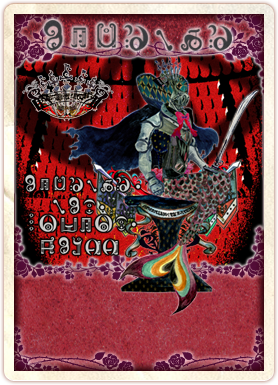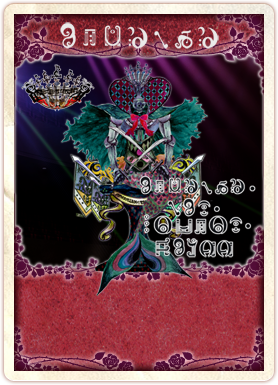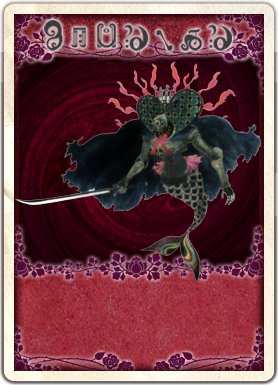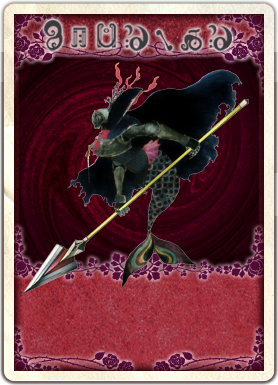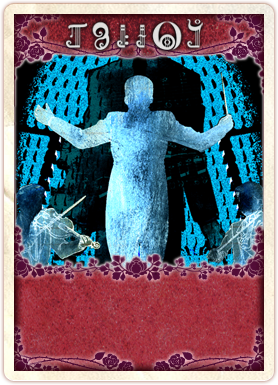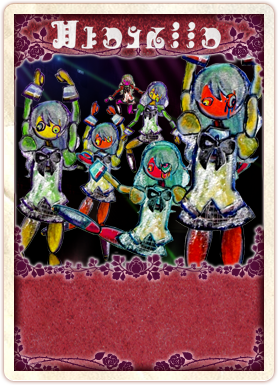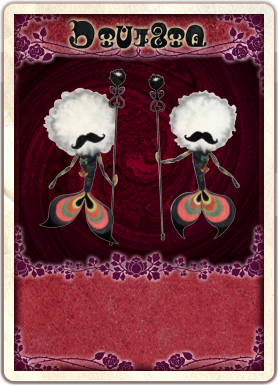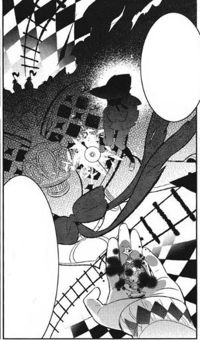Oktavia von Seckendorff: Difference between revisions
m (Orthography correction) |
|||
| (27 intermediate revisions by 11 users not shown) | |||
| Line 1: | Line 1: | ||
{{spoilers}} | |||
'''Oktavia von Seckendorff''' ({{Runes|OKTAVIA VON SECKENDORFF|variant=musical}}) is the [[witch]] form of [[Sayaka Miki]]. She briefly appears at the end of [[Episode 8]] and battles with [[Kyoko Sakura]] in [[Episode 9]]. Her Labyrinth is filled with calls for attention | '''Oktavia von Seckendorff''' ({{Runes|OKTAVIA VON SECKENDORFF|variant=musical}}) is the [[witch]] form of [[Sayaka Miki]]. She briefly appears at the end of [[Episode 8]] and battles with [[Kyoko Sakura]] in [[Episode 9]]. Her Labyrinth is filled with calls for attention — probably to [[Kyosuke Kamijo]]. Initially, the outer areas of her Labyrinth are filled with train tracks, perhaps a reflection of the train station where she became a witch. Later on, the entrance area becomes a long corridor filled with concert posters. The center of the Labyrinth appears to be a distorted concert hall, where the seats fill the domed ceiling. Her weapons appear to be manifested wheels, and the concert hall is populated with a spectral string orchestra. Oktavia also appears in one of the alternate timelines of [[Episode 10]]. | ||
Oktavia appears in | Oktavia appears again in ''[[Puella Magi Madoka Magica the Movie: Rebellion]]''. Sayaka Miki has gained the power to summon and control Oktavia due to being part of the Law of Cycles. | ||
==Witch Cards== | |||
{{Card | {{Card | ||
|name = Oktavia (Main | |name = Oktavia (Main timeline) | ||
|runes = OKTAVIA | |runes = OKTAVIA | ||
|runes_variant = musical | |runes_variant = musical | ||
| Line 17: | Line 18: | ||
{{Card | {{Card | ||
|name = Oktavia (Timeline | |name = Oktavia (Timeline 3) | ||
|runes = OKTAVIA | |runes = OKTAVIA | ||
|runes_variant = musical | |runes_variant = musical | ||
| Line 29: | Line 30: | ||
{{Card | {{Card | ||
|name = Oktavia (Rebellion | |name = Oktavia (''Rebellion'') | ||
|runes = OKTAVIA | |runes = OKTAVIA | ||
|runes_variant = musical | |runes_variant = musical | ||
|image = File:Card | |image = File:Oktavia Rebellion Card.png | ||
|japanese_desc = | |japanese_desc = 人魚の魔女。かつて恋慕の夢を見た。この魔女は円環の理の一部から再び個として切り離された。お菓子の魔女とは違い、人間体と魔女体でそれぞれ別行動が可能。この魔女は水さえあればどこからでも現れる。 | ||
|english_desc = The | |english_desc = The mermaid witch. Once dreamt of love. This witch was cut loose once again from a part of the Law of Cycles. Unlike the witch of sweets, the human and witch's body can act independently. She can appear anywhere as long as there is water. | ||
|type = Mermaid witch | |type = Mermaid witch | ||
|nature = Falling in love | |nature = Falling in love | ||
|episodes = [[The Rebellion | |episodes = ''[[Puella Magi Madoka Magica the Movie: Rebellion]]'' | ||
}} | |||
{{Card | |||
|name = Oktavia with Spear (''Rebellion'') | |||
|runes = OKTAVIA | |||
|runes_variant = musical | |||
|image = File:Oktavia Rebellion w Kyouko Spear Card.png | |||
|japanese_desc = 人魚の魔女。かつて恋慕の夢を見た。円環の理は、その魂のいくつかを切り離し地上へおよこしになりました。ひとつはお菓子の姿。もうひとつは人魚の姿。そしてさらにはご自身までもが、夜露がそっと零れるよりも恭しく地上へと降りられたのです。その姿はまるで、いつかあった少女のようでした。 | |||
|english_desc = The mermaid witch. Once dreamt of love. The Law of the Cycle split off some of its souls and sent them to the earth. One of them took the form of sweets. Another took on the form of a mermaid. And the Law of Cycles itself descended upon the surface, more reverently than the morning dew. Her form was like that of a magical girl who once was. | |||
|type = Mermaid witch | |||
|nature = Falling in love | |||
|episodes = ''[[Puella Magi Madoka Magica the Movie: Rebellion]]'' | |||
}} | }} | ||
== Minions == | == Minions == | ||
{{Card | {{Card | ||
|name = Holger (Main | |name = Holger (Main timeline) | ||
|runes = HOLGER | |runes = HOLGER | ||
|runes_variant = musical | |runes_variant = musical | ||
| Line 50: | Line 63: | ||
|type = Mermaid witch's minion | |type = Mermaid witch's minion | ||
|task = Performing | |task = Performing | ||
|episodes = [[Episode 8]], [[Episode 9]] | |episodes = [[Episode 8]], [[Episode 9]], ''[[Puella Magi Madoka Magica the Movie: Rebellion]]'' | ||
}} | }} | ||
{{Card | {{Card | ||
|name = Klarissa (Timeline | |name = Klarissa (Timeline 3) | ||
|runes = KLARISSA | |runes = KLARISSA | ||
|image = File:Card_Klarissa.png | |image = File:Card_Klarissa.png | ||
|japanese_desc = 人魚の魔女の手下。その役割はバックダンサー。魔女の後ろで陽気に踊り続けるだけの存在。 | |japanese_desc = 人魚の魔女の手下。その役割はバックダンサー。魔女の後ろで陽気に踊り続けるだけの存在。 | ||
|english_desc = The mermaid witch's minion, whose duty is a backup dancer. She only exists to dance cheerfully behind the witch | |english_desc = The mermaid witch's minion, whose duty is a backup dancer. She only exists to dance cheerfully behind the witch. | ||
|type = Mermaid witch's minion | |type = Mermaid witch's minion | ||
|task = Backup dancer | |task = Backup dancer | ||
| Line 65: | Line 78: | ||
{{Card | {{Card | ||
|name = Anthony | |name = Anthony (Rental ver.) | ||
|runes = ANTHONY | |runes = ANTHONY | ||
|image = File: | |image = File:Anthony_Rebellion_Card.png | ||
|japanese_desc = | |japanese_desc = 薔薇園の魔女の手下(レンタルver.)。その役割は造園。魔女の手下達の中ではかなり従順で数も多いため、ほむら救出の主戦力として薔薇園の魔女から派遣されて来た。直接的に人魚の魔女の指揮下へ入っているため、その魔女の影響で以前とは容姿が少し異なる。胸に付けた勲章は薔薇園の魔女から付けてもらった宝物。 | ||
|english_desc = Servants of the | |english_desc = Servants of the rose garden witch (rental ver.). They take the role of gardeners. As they are relatively docile and numerous, as far as familiars go, the rose garden witch dispatched them as the main combat force for saving Homura. As they are under the direct command of the mermaid witch, the influence of her magic has changed their appearances. The medals on their chests are a treasure added by the rose garden witch. | ||
|type = Rose garden witch's minion | |type = Rose garden witch's minion (rental ver.) | ||
|nature = Landscaping | |nature = Landscaping | ||
|episodes = [[ | |episodes = ''[[Puella Magi Madoka Magica the Movie: Rebellion]]'' | ||
}} | }} | ||
==Observations | ==Magia Record Description== | ||
*Sayaka's witch | The Doppel of falling in love. Its form is a mermaid. | ||
The master of this emotion was anguished by love, as many her age are, and chose a fate too cruel to fully bear on one’s own. | |||
Her Doppel, too, dreams of love as it swims freely through the air, producing sound from its hollow body for its master’s sake. It can even attack by using its sound waves to fling and manipulate countless swords, but as long as its master continues to use this Doppel, she may well be unable to escape the discontent that she feels deep in her chest. | |||
==Observations== | |||
*Oktavia appears in all timelines in which Sayaka makes a contract. | |||
*Oktavia's barrier shows rail tracks (as well as wheels, that may be there for the same reason), which is possibly due to what Sayaka heard from two men in the train right before she turned into a witch. | |||
**One of the alternate timelines shown in episode 10 gives her barrier a slightly different appearance with familiars that resemble [[Hitomi]]. Some design documents also indicate that [[Puella_Magi_Production_Note#Oktavia_von_Seckendorff.2C_Timeline_3_Version|Kamijou is a guitarist rather than a violinist]] in the alternate timeline. | |||
* In [[Episode 9]] when [[Kyouko]] is shown to pass through Sayaka's barrier, it is shown that when Oktavia shouts, a distorted scream is also heard and is known to be Sayaka's voice. This most likely meant Sayaka wanted to express her feelings but she could not because of her broken state. As seen before her transformation to be a witch, she had issues speaking to [[Kyouko]]. With her life reaching its end, she could not help herself in the situation. | |||
*The specific runic font used for Oktavia and Holger's cards resembles musical instruments and notation. | |||
==Trivia== | |||
*[https://en.wikipedia.org/wiki/Karl_Siegmund_von_Seckendorff Karl Sigmund von Seckendorff] was a German poet who was especially inspired by Goethe; he enjoyed composing music for several of his poems before they were even published, and translated ''The Sorrows of Young Werther'' into French. In this story, the titular man is ultimately driven to suicide by his unrequited love, as he is unable to harm or murder others to resolve the love triangle at the source of his despair. However, Goethe thought little of his work. | |||
**He also wrote a book called ''The Wheel of Fate'' (''Das Rad des Schicksals''), and could explain Sayaka's wheel attack. | |||
*Seckendorff was also the name of a [[:file:Close up Sayaka coats of arm and the Seckendorff family coats of arm.png|Frankish knight from a noble family.]] | *Seckendorff was also the name of a [[:file:Close up Sayaka coats of arm and the Seckendorff family coats of arm.png|Frankish knight from a noble family.]] | ||
*Oktavia is the German form of the | *Oktavia is the German form of the Latin name ''Octavia'' which means "the eighth" (child, month or musical interval) or "from the family Octavia". It is the direct root of [[Wikipedia:Octave|octave]] in English (an octave being the eight interval of a scale). The name was most likely chosen because of the link between Sayaka and music. | ||
** It might also reflect how her first appearance was in episode eight. | ** It might also reflect how her first appearance was in episode eight. | ||
*The entrance to her barrier has the sayings ''Love Me Do'', which is, incidentally, a Beatles song. | *The entrance to her barrier has the sayings ''Love Me Do'', which is, incidentally, a Beatles song. | ||
*Holger is a Scandinavian masculine given name derived from the Old Norse name ''Hólmgeirr'', the prefix ''hólmr'' meaning "island", and the suffix ''geirr'' meaning "spear". It is most common amongst Danish people. [http://en.wikipedia.org/wiki/Holger_%28given_name%29] | *Holger is a Scandinavian masculine given name derived from the Old Norse name ''Hólmgeirr'', the prefix ''hólmr'' meaning "island", and the suffix ''geirr'' meaning "spear". It is most common amongst Danish people. [http://en.wikipedia.org/wiki/Holger_%28given_name%29] | ||
*''‘Herr Holger’'' is an old Swedish song [http://www.youtube.com/watch?v=pjmq6KI0D_o] performed by the dark folk band [http://en.wikipedia.org/wiki/Garmarna Garmarna]. Its central character, Sir Holger, gets beheaded for his crimes and buried, but then turns undead and goes back to his wife to warn her against going to Hell. Yet the lady won't listen to the warning: ''‘Go to Hell with your squires, … And I will follow with my maidens’''. | *''‘Herr Holger’'' is an old Swedish song [http://www.youtube.com/watch?v=pjmq6KI0D_o] performed by the dark folk band [http://en.wikipedia.org/wiki/Garmarna Garmarna]. Its central character, Sir Holger, gets beheaded for his crimes and buried, but then turns undead and goes back to his wife to warn her against going to Hell. Yet the lady won't listen to the warning: ''‘Go to Hell with your squires, … And I will follow with my maidens’''. | ||
*In the beginning of episode 9 near the name of the witch, there are floating notes of "Symposium Magarum" | *In the beginning of episode 9 near the name of the witch, there are floating notes of "Symposium Magarum" | ||
*[https://en.wikipedia.org/wiki/Holger_Simon_Paulli| Holger Simon Paulli] was a Danish conductor and composer who contributed to the spread of Richard Wagner's work with his performances of ''Lohengrin'' and ''Die Meistersinger von Nürnberg.'' | |||
*The Movie version has new runes, in it Oktavia's barrier has [[:file:New runes sayaka barrier.jpg|runes that read]], "[[:wikipedia:Summis_desiderantes_affectibus|Desiderantes Affectibus]]": Summis desiderantes affectibus (Latin: ''"Desiring with supreme ardor"'') was a papal bull issued by Pope Innocent VIII on December 5, 1484. The bull was written in response to the request of Dominican Inquisitor Heinrich Kramer for explicit authority to prosecute witchcraft in Germany, after he was refused assistance by the local ecclesiastical authorities. The bull recognized the existence of witches. | *The Movie version has new runes, in it Oktavia's barrier has [[:file:New runes sayaka barrier.jpg|runes that read]], "[[:wikipedia:Summis_desiderantes_affectibus|Desiderantes Affectibus]]": Summis desiderantes affectibus (Latin: ''"Desiring with supreme ardor"'') was a papal bull issued by Pope Innocent VIII on December 5, 1484. The bull was written in response to the request of Dominican Inquisitor Heinrich Kramer for explicit authority to prosecute witchcraft in Germany, after he was refused assistance by the local ecclesiastical authorities. The bull recognized the existence of witches. | ||
**The bull, which synthesized the spiritual and the secular crimes of witchcraft, is often viewed as opening the door for the witchhunts of the early modern period. | **The bull, which synthesized the spiritual and the secular crimes of witchcraft, is often viewed as opening the door for the witchhunts of the early modern period. | ||
*Oktavia is briefly shown in Kazumi Magica as background when Juubey explains how a magical girl becomes a witch. | |||
*It appears Sayaka Miki is the only Puella Magi that has been shown to be able to separate from her Witch, as in Rebellion Oktavia fights along Sayaka as a separate being meaning Sayaka no longer has to turn into her. | |||
[[File:Kazumi oktavia.jpg|right|200px]] | [[File:Kazumi oktavia.jpg|right|200px]] | ||
=== | ==Gallery== | ||
See [[Gallery:Oktavia]] | |||
== External Links == | == External Links == | ||
Revision as of 21:29, 14 September 2018
This section may contain major spoilers!
Please refrain from reading if you are not yet familiar with all the latest media released.Oktavia von Seckendorff (OKTAVIA VON SECKENDORFF) is the witch form of Sayaka Miki. She briefly appears at the end of Episode 8 and battles with Kyoko Sakura in Episode 9. Her Labyrinth is filled with calls for attention — probably to Kyosuke Kamijo. Initially, the outer areas of her Labyrinth are filled with train tracks, perhaps a reflection of the train station where she became a witch. Later on, the entrance area becomes a long corridor filled with concert posters. The center of the Labyrinth appears to be a distorted concert hall, where the seats fill the domed ceiling. Her weapons appear to be manifested wheels, and the concert hall is populated with a spectral string orchestra. Oktavia also appears in one of the alternate timelines of Episode 10.
Oktavia appears again in Puella Magi Madoka Magica the Movie: Rebellion. Sayaka Miki has gained the power to summon and control Oktavia due to being part of the Law of Cycles.
Witch Cards
The mermaid witch; it is in her nature to fall in love. Looking for the feeling that moved her so long ago, she moves with the entire concert hall. Her fortune only turns under the weight of memories and no longer moves toward the future. Nothing will reach her any longer. She will come to know nothing more. She simply allows no one to disturb her minions' playing. | |||||||||||
The mermaid witch. Her nature is to fall in love. The witch continues to dream of a guitar resounding in the middle of a concert hall, a deeply moving impression from past days. Repeating within that time with little but sure differences, her wheels of fate move around calmly. | |||||||||||
The mermaid witch. Once dreamt of love. This witch was cut loose once again from a part of the Law of Cycles. Unlike the witch of sweets, the human and witch's body can act independently. She can appear anywhere as long as there is water. | |||||||||||
The mermaid witch. Once dreamt of love. The Law of the Cycle split off some of its souls and sent them to the earth. One of them took the form of sweets. Another took on the form of a mermaid. And the Law of Cycles itself descended upon the surface, more reverently than the morning dew. Her form was like that of a magical girl who once was. | |||||||||||
Minions
The mermaid witch's minion, whose duty is to perform. Several of them form a hollow orchestra that continually plays music for the witch. People who listen to their music for long enough will lose their soul. This orchestra only exists for its witch; to her, the orchestra is everything. | |||||||||||
The mermaid witch's minion, whose duty is a backup dancer. She only exists to dance cheerfully behind the witch. | |||||||||||
Servants of the rose garden witch (rental ver.). They take the role of gardeners. As they are relatively docile and numerous, as far as familiars go, the rose garden witch dispatched them as the main combat force for saving Homura. As they are under the direct command of the mermaid witch, the influence of her magic has changed their appearances. The medals on their chests are a treasure added by the rose garden witch. | |||||||||||
Magia Record Description
The Doppel of falling in love. Its form is a mermaid. The master of this emotion was anguished by love, as many her age are, and chose a fate too cruel to fully bear on one’s own. Her Doppel, too, dreams of love as it swims freely through the air, producing sound from its hollow body for its master’s sake. It can even attack by using its sound waves to fling and manipulate countless swords, but as long as its master continues to use this Doppel, she may well be unable to escape the discontent that she feels deep in her chest.
Observations
- Oktavia appears in all timelines in which Sayaka makes a contract.
- Oktavia's barrier shows rail tracks (as well as wheels, that may be there for the same reason), which is possibly due to what Sayaka heard from two men in the train right before she turned into a witch.
- One of the alternate timelines shown in episode 10 gives her barrier a slightly different appearance with familiars that resemble Hitomi. Some design documents also indicate that Kamijou is a guitarist rather than a violinist in the alternate timeline.
- In Episode 9 when Kyouko is shown to pass through Sayaka's barrier, it is shown that when Oktavia shouts, a distorted scream is also heard and is known to be Sayaka's voice. This most likely meant Sayaka wanted to express her feelings but she could not because of her broken state. As seen before her transformation to be a witch, she had issues speaking to Kyouko. With her life reaching its end, she could not help herself in the situation.
- The specific runic font used for Oktavia and Holger's cards resembles musical instruments and notation.
Trivia
- Karl Sigmund von Seckendorff was a German poet who was especially inspired by Goethe; he enjoyed composing music for several of his poems before they were even published, and translated The Sorrows of Young Werther into French. In this story, the titular man is ultimately driven to suicide by his unrequited love, as he is unable to harm or murder others to resolve the love triangle at the source of his despair. However, Goethe thought little of his work.
- He also wrote a book called The Wheel of Fate (Das Rad des Schicksals), and could explain Sayaka's wheel attack.
- Seckendorff was also the name of a Frankish knight from a noble family.
- Oktavia is the German form of the Latin name Octavia which means "the eighth" (child, month or musical interval) or "from the family Octavia". It is the direct root of octave in English (an octave being the eight interval of a scale). The name was most likely chosen because of the link between Sayaka and music.
- It might also reflect how her first appearance was in episode eight.
- The entrance to her barrier has the sayings Love Me Do, which is, incidentally, a Beatles song.
- Holger is a Scandinavian masculine given name derived from the Old Norse name Hólmgeirr, the prefix hólmr meaning "island", and the suffix geirr meaning "spear". It is most common amongst Danish people. [1]
- ‘Herr Holger’ is an old Swedish song [2] performed by the dark folk band Garmarna. Its central character, Sir Holger, gets beheaded for his crimes and buried, but then turns undead and goes back to his wife to warn her against going to Hell. Yet the lady won't listen to the warning: ‘Go to Hell with your squires, … And I will follow with my maidens’.
- In the beginning of episode 9 near the name of the witch, there are floating notes of "Symposium Magarum"
- Holger Simon Paulli was a Danish conductor and composer who contributed to the spread of Richard Wagner's work with his performances of Lohengrin and Die Meistersinger von Nürnberg.
- The Movie version has new runes, in it Oktavia's barrier has runes that read, "Desiderantes Affectibus": Summis desiderantes affectibus (Latin: "Desiring with supreme ardor") was a papal bull issued by Pope Innocent VIII on December 5, 1484. The bull was written in response to the request of Dominican Inquisitor Heinrich Kramer for explicit authority to prosecute witchcraft in Germany, after he was refused assistance by the local ecclesiastical authorities. The bull recognized the existence of witches.
- The bull, which synthesized the spiritual and the secular crimes of witchcraft, is often viewed as opening the door for the witchhunts of the early modern period.
- Oktavia is briefly shown in Kazumi Magica as background when Juubey explains how a magical girl becomes a witch.
- It appears Sayaka Miki is the only Puella Magi that has been shown to be able to separate from her Witch, as in Rebellion Oktavia fights along Sayaka as a separate being meaning Sayaka no longer has to turn into her.
Gallery
See Gallery:Oktavia
External Links
- Oktavia von Seckendorff card at official website (Japanese)
- Oktavia von Seckendorff card at official website (Japanese) (Alternative card)
- Holger card at official website (Japanese)
- Klarissa card at official website (Japanese)
- Oktavia Von Sekendorff pixiv fanart
